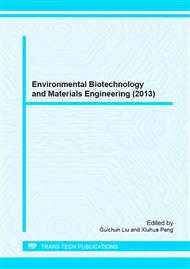p.434
p.440
p.444
p.449
p.453
p.457
p.461
p.467
p.472
Study on Chemical Pre-Oxidation Enhanced Coagulation for Micro-Polluted Raw Water Treatment
Abstract:
The present paper studied the enhanced effects of O3 and KMnO4 as chemical oxidants on traditional coagulation for micro-polluted raw water treatment. Results showed that pre-oxidation using either ozone or KMnO4 could effectively improve the removal of turbidity and organic matters by coagulation. Compared with mere coagulation by polyaluminium chloride (PAC), pre-oxidation using 2 mg/l O3 for 20 minutes could increase the removal rates of both turbidity and total organic carbon by 5.33% and 5.06%. However, the effectiveness of pre-oxidation using KMnO4 was not as significant as that using O3. Besides the direct mineralization of small organic molecules into CO2 and H2O, O3 and KMnO4 could also destroy complex macromolecules in raw water. Therefore, the SUVA value of the effluent decreased markedly after the pre-oxidation and the subsequent coagulation. Based on these results, the process of chemical pre-oxidation enhance coagulation were expected to reduce the disinfection by-products formation potential.
Info:
Periodical:
Pages:
472-475
Citation:
Online since:
September 2013
Authors:
Keywords:
Price:
Сopyright:
© 2013 Trans Tech Publications Ltd. All Rights Reserved
Share:
Citation:


